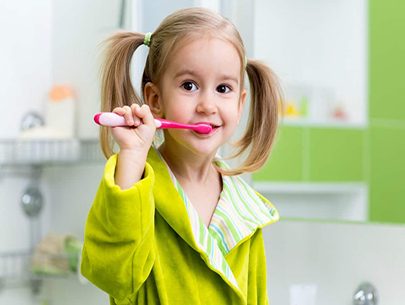13 Simple Teeth Brushing Points
1. Begin by selecting the appropriate toothbrush type.
The first step in properly cleaning your teeth is using the appropriate toothbrush. Since manual and electric toothbrushes are the most often used toothbrush kinds, this page focuses on them. To find out if using a different kind of toothbrush in addition to your existing one could improve your oral health, make sure to read our blog post on toothbrush kinds. After all, using more than one kind of brush is sometimes required.
2. Make Use of an Electric Brush As an Alternative to a Manual Brush
People who use electric toothbrushes have healthier gums, fewer cases of dental decay, and their teeth stay intact longer than those who use manual toothbrushes, according to studies, including one from the NCBI¹. Electric toothbrushes are frequently recommended for those with braces, gum disease, or other sensitivities since they also assist prevent vigorous brushing.
3. Employ the Proper Brushing Method
Using an electric toothbrush is a terrific first step, but you need be careful to use the proper technique. For information on the proper angle, direction, and other aspects of your regular brushing regimen, see our blog entry on how to brush your teeth.
4. Steer clear of hard-bristled brushes.
We advise selecting a toothbrush with a soft or extra-soft bristle head. Stiff or hard bristles can be hard on your gums and harm the structure of your teeth. Because many people erroneously think that harsh bristles are more effective than soft ones, there is a demand for them. Instead of teaching people why they shouldn’t use them, manufacturers find it easier and more profitable to produce them.

5. Use Light Pressure
Many people believe that in order to properly clean your teeth, you must brush them with a lot of pressure. However, excessive use might erode your enamel and result in receding gums. Instead, let the toothbrush perform the majority of the work and apply light pressure. If you haven’t already, you might want to think about moving from a manual toothbrush to an electric one since it makes this task easier. Even pressure sensors are included with some electric brushes, like Sonicare. If you would rather use a manual toothbrush, you can use your fingertips rather than your full hand to get the right grip.
6. Use a brush twice day.
Brushing with fluoride toothpaste twice a day for two minutes each is advised by the Australian Dental Association (ADA).² Never clean your teeth right before bed to help prevent cavities. By eliminating food and drink residue that can cause plaque and tartar, brushing twice a day can also help whiten your teeth. Check out another of our blog posts for more fantastic teeth-whitening advice if you’re interested in getting whiter teeth.
7. Remember to Change Your Toothbrush
We advise changing your toothbrush every three to four months, but if you have recently been ill and wish to prevent reinfection, you can change it more frequently. Additionally, if you observe bristle wear, we advise replacing your brush sooner rather than later.
8. Use toothpaste with fluoride.
Yes, since the 1950s, the Australian Dental Association has advised using fluoride toothpaste. Fluoride, which has long been considered safe and effective, fortifies tooth enamel and guards against decay.
Studies have shown that toothpastes containing hydroxyapatite help restore lost enamel, if you would rather not use fluoride. For medical patients who have trouble utilizing fluoride, such as those with thyroid conditions, hydroxyapatite is also a great option.
9. Hold off on brushing after consuming acidic foods or beverages.
Tomato sauce and orange juice are examples of acidic foods and beverages that might weaken tooth enamel, so it’s recommended to wait 30 minutes after consuming them before brushing your teeth. To counteract the acids in the interim, swish water around your mouth.
10. Don’t Overbrush
The secret to healthy teeth and gums is regular brushing. However, brushing too frequently (more than three times a day) might result in sensitive teeth, tooth abrasions, and receding gums.
11. Avoid Rinsing Right After Brushing
It is preferable to spit out toothpaste containing fluoride or hydroxyapatite rather than rinse it out with water after brushing. Rinsing lessens its effectiveness and removes it from your teeth. Since you’re just using a pea-sized amount of toothpaste, it’s quite acceptable to leave traces of hydroxyapatite or fluoride behind.
12. Floss Prior to Brushing, Not After
We think that flossing should always come before brushing. In order to help clear your mouth of any loose particles before brushing your teeth, we also think you should rinse after flossing.
13. Always Floss
Indeed! The Australian Dental Association advises using dental floss or an interdental brush to clean in between your teeth once a day. Because teeth have five surface layers and brushing only cleans three of them, brushing without flossing is only about 60% effective at cleaning your teeth. Additionally, flossing keeps your general health and helps avoid gum disease.
In brief
It simply takes a few minor adjustments and the formation of positive habits to maintain the health of your teeth for the rest of your life and to have a bright, self-assured grin. Use the above advice when brushing your teeth, and both your teeth and your dentist will appreciate it!






